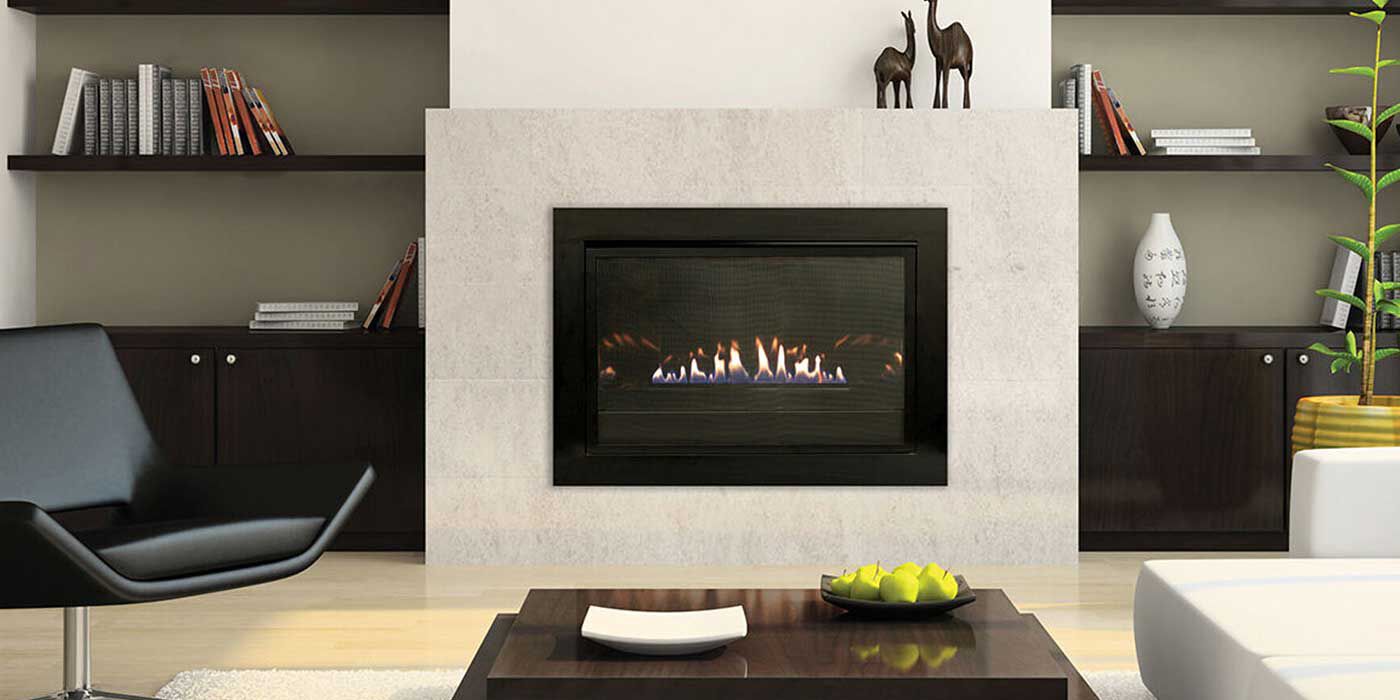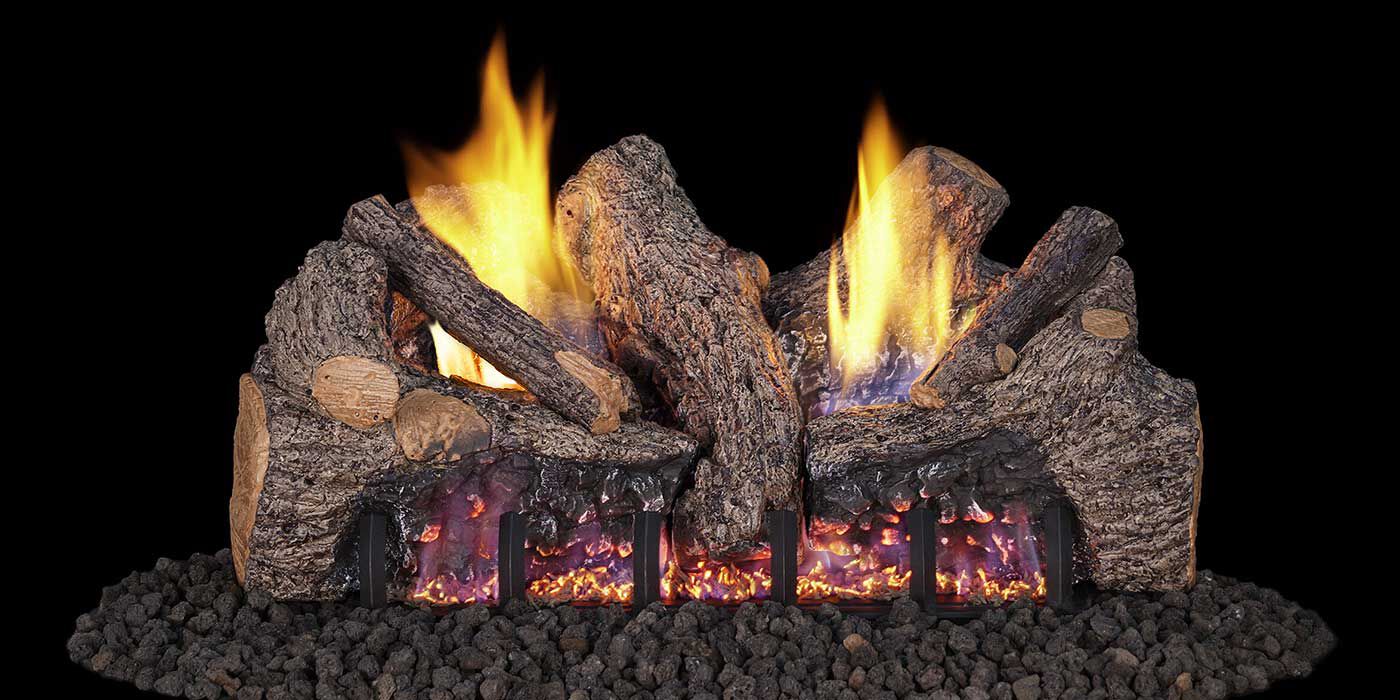By: Tiffany Kurilla, NFI Certified Master Hearth Professional
Last Updated: August 23, 2024
Adding a Ventless, or Vent-Free, fireplace is a popular solution for homeowners who want the look and feel of a wood burning fireplace without committing to the costly renovations required to add a chimney.
Ventless fireplaces are specifically designed to burn at nearly 100% efficiency, leaving no smoke and little to no fumes behind. Plus, you can put one in practically any room of the house.
When installed correctly, Ventless appliances serve as excellent secondary heating solutions and are considered very safe. They’re also equipped with safety systems that prevent poor air quality and reduce health risks.
We’ve outlined the most important things you need to know about Ventless fireplaces to help you determine if it’s safe to install one in your home.
How Ventless Fireplaces Work
Ventless gas fireplaces don’t require a chimney or venting system of any kind, allowing all the heat that’s produced to stay inside your home.
They function on a closed-loop system and rely on natural convection. Cool indoor room air is drawn into the firebox for combustion, then hot exhaust is expelled into the room.
Equipped with special burners that use a small amount of Natural Gas or Propane, Ventless units emit little to no gases after combustion. What remains will typically be made up of water vapor and carbon dioxide.
Though any dangerous gases left will be minimal and within safe limits, Ventless fireplaces include built-in sensors that monitor the oxygen level in the room. This important feature allows them to operate safely without a chimney.
Ventless Fireplace Safety Concerns
Certain states, like California, have outlawed indoor installations of Ventless fireplaces altogether, while others have strict installation requirements.
If you’re installing a Ventless appliance in your home or commercial space, always take the safe route and check your local building, city, state, and fire codes, along with the minimum room size requirement to ensure your product is compliant.
Lung Irritation
Ventless appliances can intensify odors that are already present inside your home.
Impurities, such as pet hair, scented candles, fresh paint, and cleaning chemicals, are drawn into the firebox, along with the fresh indoor room air used for combustion.
When these scents are emitted back into the room, they often become stronger and can potentially cause lung irritation in sensitive individuals.
For this reason, it’s not recommended to install a Ventless fireplace if you or someone in your household has asthma, allergies, or chronic bronchitis.
Increased Humidity Levels
As oxygen burns for combustion in a Ventless fireplace, water vapor is produced, which increases humidity levels in your home. This can be a great source of extra moisture in the dry winter months, especially if you live in a cold climate.
However, if you plan on letting your Ventless fireplace burn for an extended amount of time, it’s recommended to leave a window cracked near the fireplace to prevent excess condensation, which could lead to mold or mildew growth.
Required Safety Precautions
Oxygen Depletion Sensors
Without enough oxygen, Ventless fireplaces won’t burn cleanly. For this reason, each fireplace is equipped with an Oxygen Depletion Sensor (ODS), which monitors the oxygen levels in the room and automatically shuts the fireplace off if oxygen levels drop below the safe threshold of 18%.
You will also need to install a carbon monoxide detector near your fireplace as a secondary precaution.
BTU Limits
While Ventless fireplaces make great secondary heating sources, they are limited to a maximum of 40,000 BTUs per hour to ensure there is enough oxygen left in the room.
For bedroom and bathroom installations, the maximum BTU output is even more limited, allowing only 6,000 to 10,000 BTUs, no matter the size of the space.
Approved Burning Media
Ventless fireplaces come with a variety of media options, like fire glass, gas logs, and firestones.
If you choose gas logs for your media bed, they must be installed to the manufacturer’s specifications and cannot be modified in any way. Ventless gas logs are designed to fit together in a specific pattern to prevent the flames from impinging on the logs.
If the flames brush against the log set inside your Ventless fireplace, the finishing material will burn off and create harmful byproducts that infiltrate your home.
Always be sure to follow the diagram in the installation manual to ensure you’ve achieved the proper placement for your Ventless gas logs.
Installation Guidelines
Since they don’t require a chimney or venting of any kind, Ventless appliances offer you more freedom and flexibility to add ambiance to a variety of spaces. They’re ideal for condos, apartments, offices, and high-rise penthouses due to their straightforward installation.
However, Ventless fireplaces will require a hard-piped gas line for installation. If you don’t have a gas line inside of your home already, you’ll need to hire a licensed professional in your area to install one for you.
To make sure you’re selecting an appropriate and safe location for your Ventless fireplace, we recommend choosing a few models that you like, then checking the installation manuals for specific installation requirements.
Be sure to measure the cubic footage of your space to make sure it’s compliant with the room size requirements noted in each manual.
From there, you’ll need to ensure the fireplace and location you’ve chosen satisfy your local, city, and state codes.
Once you’ve purchased your Ventless fireplace, you’ll need to hire a license professional to install it.
If an individual who isn’t adequately trained and certified in gas products installs the fireplace, the warranty will be void on your product and you may encounter technical issues, or severe health and safety concerns.
Your certified installer will simply follow the instructions in the installation manual that comes with your Ventless fireplace.
If you or your installer have questions about fire codes, the instruction manual, or installation requirements, please call our team of NFI certified experts at 800.919.1904 and we’ll walk you through the process.
Pro Tip:
We highly recommend choosing a gas professional certified by the National Fireplace Institute (NFI).
Our Best-Selling Ventless Fireplaces
Prefer to Listen?
We're Here to Help
Have more questions about Ventless gas fireplaces? We’d love to help! Call our team of NFI certified experts today at 800.919.1904.
More Resources
Learn the differences between Ventless and Vented gas fireplaces to find the perfect model for your home!
Still stumped on the right Ventless fireplace style for your space? Check out our top 5 models to gain some inspiration.
Discover several great advantages Ventless gas fireplaces have over their wood burning counterparts.
 |
Tiffany Kurilla, Technical Sales Representative, has five years of experience at Woodland Direct. As an NFI-Certified Master Hearth Professional, she’s recognized for her deep knowledge of fireplace products and safety standards. Tiffany’s dedication and mastery earned her the title of Woodland’s top sales representative in 2021 and 2022. Outside of work, Tiffany is an avid traveler, exploring national and international destinations. Her favorite spot to visit? The Happiest Place on Earth — Disney World! Call Tiffany or one of our experts in fire at 800.919.1904. |








